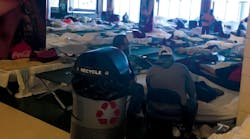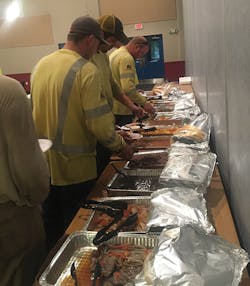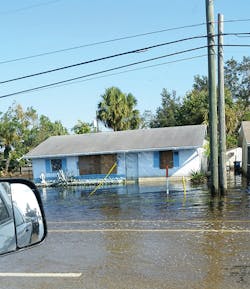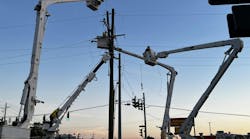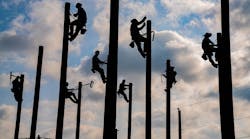When Hurricane Irma made landfall, the largest restoration workforce in American history responded, including many line contractors. For example, American Transmission Company (ATC) sent two of its contractors — Henkels & McCoy and M.J. Electric — to Florida to assist Florida Power & Light.
“We were all paying close attention to this storm before it hit [Florida]. Even though we were distanced from the impact, we wanted to help,” says Matt Weber, ATC’s director of construction. “After looking at the scheduled work in our service area and discussing it with both Henkels & McCoy and M.J. Electric, we all knew the right thing to do — deploy crews as soon as possible and aid in the restoration process.”
After the companies contacted the linemen by cell phone, they had about a 12- to 14-hour turnaround before they loaded up their bucket trucks and hit the road. Henkels & McCoy sent 479 linemen from all over the country, some coming from as far away as California.
“The number depends on the customer’s needs, and the duration is determined by the amount of damage from the storm,” says Jim Terry, safety manager of power for Henkels & McCoy. “For Irma, most crews were gone for two weeks; for Katrina, crews were gone for three months.”
Meanwhile, 31 M.J. Electric resources came from ATC’s footprint.
“We sent employees who have the ability to do energized distribution work and who were not committed to high-priority projects,” says Paul Phillips, M.J. Electric’s director of operations.
Deploying Crews
When going to work on another company’s system, line contractors ensure that their crews are well prepared with the proper tools and technology. For Henkels & McCoy, grounding tools were a top priority including grounds, hot sticks, testers and flagging for installed grounds. In addition, the linemen used distribution tooling, road signage, insulating cover, water, food and some basic hygiene products.
To keep their crews both safe and productive, M.J. Electric supplied the crews with a V watch (a personal voltage detector), lights, water, coolers, rain suits, stick saws, personal protective equipment and many distribution tools for crews who are typically geared up to handle transmission work.
Once the vehicles were well stocked and fueled up, Henkels & McCoy sent out the crews from a specific area as a convoy.
“Linemen love going on storm duty since it is when they feel most appreciated by the community for the work that we do,” Terry says.
M.J. Electric’s crews also all travel together when they go out on a storm restoration. The lead driver looks for enough parking, food and gas for the crews, checks scales for the vehicles and equipment, and handles any IPASS/EZPasses to ensure safe travels for all the linemen. Then, at the tail end of the caravan, the mechanic serves as the caboose in case one of the linemen experiences a vehicular breakdown or needs a tire change.
Enduring Challenging Conditions
During the storm restoration process, the linemen had to confront many challenges because of the widespread power outages.
“The conditions were poor with no power, water or any other basic items, but crews all understand that going in,” Terry says. “They work 16 to 18 hours a day, simply eating sandwiches or nothing at all; there is no place to take a shower or sometimes sleep, other than their truck.”
While some of the Henkels & McCoy crews slept on cots arranged at open shelters, others stayed overnight in bunk beds at camps, and a few had hotel rooms. During the restoration, M.J. Electric’s crews were directed to sleep in an ice arena.
“These conditions were not ideal for rest, especially while working long hours in the heat; therefore, our crews elected to get hotel rooms,” Phillips says.
Typically, on storm restoration projects, the customer provides three meals a day, and the amount they provide depends on the size of the utility and the conditions of power and water.
Conditions for Irma, however, were better than prior storms, and the damage was far less than the linemen have previously encountered in most areas, Phillips says.
When M.J. Electric crews arrived in Florida, they were first sent to Lake City for an orientation by Florida Power & Light. Next, they were relocated to Ft. Lauderdale, where they were told to “ride out the storm.”
“Our crews were nervous because we are from the North; many of our folks have never been through a hurricane,” Phillips says.
When Hurricane Irma finally hit, Phillips compared it to a widespread tornado with so many trees being down.
The hurricane also caused flooding, and to continue working in the wet and muddy conditions, Henkels & McCoy furnished muck boots or waders for the line crews to work in flood zones. Also, the crews used boats to approach work sites and structures.
Restoring Power
To ensure the linemen stayed safe during the storm restoration, M.J. Electric organized its own daily crew hazard awareness meetings. During these briefings, the linemen discussed hazards from the day before, upcoming task hazards, and Quanta safety alerts that were hurricane-specific.
The Henkels & McCoy crews focused on repairing the downed lines, starting with the main feeders, then moving on to the taps, and finally, working on any service connections or tickets when the storm work was winding down.
“Typically, we worked 16- to 18-hour days starting at 5 a.m. and ending at 10 p.m. or 11 p.m. Some customers require shift work, so there was a presence 24 hours a day, but that was rare,” Terry says.
Connecting with the Community
The linemen for both Henkels & McCoy and M.J. Electric not only helped to turn the lights back on for the customers, but they also connected with the local communities.
“Henkels & McCoy is especially cordial to the communities we work in, and people offer us food and water,” Terry says.
The city of Wilton Manors was also especially accommodating to the M.J. Electric crews by providing parking, ice, dumpsters and bathrooms, and office space for its superintendent and its FPL representative. In addition, they provided sandwiches for a few of the linemen, a few times for lunch and then for all the crews another day. Also, Redland Middle School allowed the contractor to park its trucks within their secured fence with 24-hour surveillance, which saved the linemen hours of commuting time. The local community also showed their appreciation in other ways.
“The owner of Stork’s Bakery and Coffee House Bakery provided cookies when power was restored to his shop,” Phillips says. “Many homeowners allowed crews to use their bathrooms and one even provided chicken and ribs.”
Assisting Texas
Not just one hurricane, but three — Harvey, Irma and Maria — all hit within a short time frame. Typically, when this happens, the power companies won’t release crews unless they are clear of the storm. For example, after the crews were released from Hurricane Irma, there was still a need to fix some transmission towers in Houston, Texas, for CenterPoint Energy. As such, M.J. Electric released 13 M.J. Electric employees to help assist with that effort.
By working with both the Florida and Texas utilities, the linemen were able to swiftly and safely handle the power outages and allow their customers to move forward.
“At ATC, our contractors are our partners,” Weber says. “Their commitment to assist with the aftermath of these storms demonstrates how they truly excel. We applaud them and the many others who put personal commitments aside, offering their skilled expertise to restore power for the many people who needed it.” ♦
